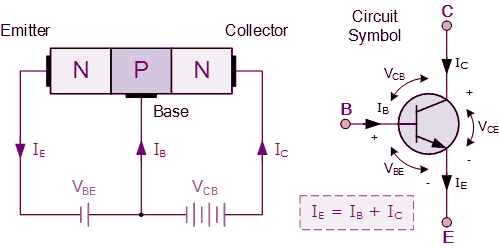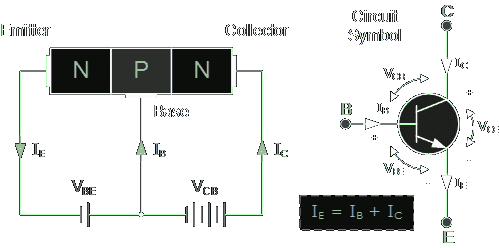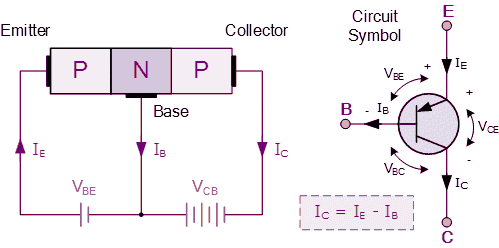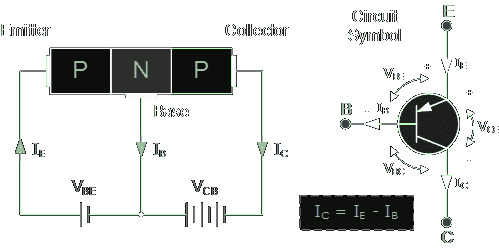The NPN needs current to be pushed into the base to turn the transistor on, whereas the PNP needs current to be pulled out of the base to turn it on (referring to conventional current flow here). In other words, the NPN needs the base to be more positive than the emitter, whereas the PNP needs the base to be more negative than the emitter. Transistors are current-driven devices; they require significant current flow to operate. Most times the current flow needed in the base is 50 to 100 times less than the amount flowing through the emitter and collector.
The NPN transistor is a bipolar junction transistor. In an NPN transistor, the first letter N indicates a negatively charged layer of material and a P indicates a positively charged layer. These transistors have a positive layer, which is located in-between two negative layers. NPN transistors are generally used in circuits for switching, amplifying the electrical signals that pass through them. These transistors comprise three terminals: base, collector and emitter and these terminals connect the transistor to the circuit board. When the current flows through the NPN transistor, the transistor base terminal receives the electrical signal, the collector makes a stronger electric current than the one passing through the base, and the emitter passes this stronger current on to the rest of the circuit. In this transistor, the current flows through the collector terminal to the emitter. The application of an NPN transistor is on a computer circuit board. Computers need all their information to be translated into binary code, and this process is accomplished through a plenty of small switches flipping on and off on the computers circuit boards. NPN transistors can be used for these switches. A powerful electric signal turns the switch on, whereas a lack of a signal turns the switch off.

The PNP transistor is a bipolar junction transistor. In a PNP transistor, the first letter P indicates the polarity of the voltage required for the emitter; the second letter N indicates the polarity of the base. The working of PNP transistor is the exact opposite to the NPN transistor. In this type of transistor, the majority charge carriers are holes. The materials which are used to construct the emitter, base and collector terminals in the PNP transistor are different from those used in the NPN transistor. The base-collector terminals of the PNP transistor are always reversed biased, then the negative voltage must be used for the collector. Therefore, the base terminal of the PNP transistor must be negative with respect to the emitter terminal, and the collector must be negative than the base.

Bipolar Junction transistors are three terminal device and these are made of doped materials, often used in amplifying and switching applications. In essence, there are a couple of PN junction diodes in every BJT. When the pair of diodes joined then it forms a sandwich that places a type of semiconductor in between the same two types. Therefore, there are only two types of bipolar sandwich, which are namely NPN and PNP. In semiconductors, the NPN’s has characteristically higher electron mobility compared to the hole mobility. Therefore, it permits a large amount of current and operates very fast.
Both NPN and PNP transistors are composed of different materials and current flow of these transistors is also dissimilar. In an NPN transistor, the current flows from the collector (C) to the Emitter (E), whereas in a PNP transistor, the current flows from the emitter to the collector.
In an NPN transistor, a positive voltage is given to the collector terminal to produce a current flow from the collector to emitter. For PNP transistor, a positive voltage is given to the emitter terminal to produce current flow from the emitter to collector.
The working principle of an NPN transistor is such that when we increase current to the base terminal, then the transistor turns ON and it conducts fully from the collector to emitter. When we decrease the current to the base terminal, the transistor turns ON less and until the current is so low, the transistor no longer conducts across the collector to emitter, and shuts OFF.
The working principle of a PNP transistor is such that when the current exists at the base terminal of the transistor, then the transistor shuts OFF. When there is not current at the base terminal of the PNP transistor, then the transistor turns ON.
Transistors are used as building blocks to create integrated circuits; a series of integrated circuit chips released in 1962., known as the 7400 series, provided a wide variety of digital logic functions such as AND, OR, and NOT gates. The technology was known as TTL, which stands for Transistor to Transistor Logic, implemented using BJTs and resistors. An important part of digital logic circuits is a flip-flop (RS flip-flop, D flip-flop, JK flip-flop), which is a circuit that is able to remain in one of two states. They have memory that normal logic gates, like the NAND and NOR gates, lack. Utilizing flip-flops, we can build various types of functional circuits, such as shift register, ripple counter.
Logic
One of the most incredible growth industries over the last 50 years has come from the application of electronics to manipulate data based on the principles of Boolean logic. Originally developed by George Boole in the mid-1800s, Boolean logic is based on a very simple concept: let the value 1 mean true, and let the value 0 mean false. In an actual circuit, 1 might typically be any signal between 3 to 5 V, and 0 any signal between 0 to 2.9 V, but what is important in the world of logic is that there are only two states, 1 or 0. Some basic components that manipulate logic are called gates.
The NOT Gate
The NOT gate inverts whatever signal we put into it; put in a 1, get a 0 out, and vice versa. The NOT gate, also called the inverter, is commonly represented by the symbol below. 
The AND Gate
The AND function is described by the rule that all inputs need to be true or 1 in order for the output to be true. However, if either is false, the output must be false. 
The OR Gate
The OR gate is sort of the opposite, but not exactly, to the AND gate. It only takes one true input to create a true output; false output is only in case of both false inputs. 
These are three basic gates, there are more gates, but they are all built from these three. If we understand them, we can derive the rest.
Computers also use other logic gates like NAND, NOR, and XOR. Each logic gate operates on inputs in a slightly different way; they output 1 and 0 in different situations.
The NAND and NOR gates are known as universal logic gates, which means that we can build any of the other gates with only NAND gates or only NOR gates. Computer hardware manufacturers prefer to use NAND gates due to their universality and ease of fabrication, so our computer likely has millions of NAND gates inside its circuitry.
We send information through computers using wires that represent 1s and 0s. Computers need a way to manipulate those 1s and 0s, so that they can eventually do more complicated operations like calculating the 50th digit of π, for example. Computers use logic gates to transform the 1s and 0s from input wires. A logic gate accepts inputs and then outputs a result based on their state.
A number system is a system representing numbers. It is also called the system of numeration and it defines a set of values to represent a quantity.
The binary number system uses only two digits: 0 and 1. The numbers in this system have a base of 2. Digits 0 and 1 are called bits and 8 bits together make a byte. The data in computers is stored in terms of bits and bytes. The octal number system uses eight digits: 0,1,2,3,4,5,6 and 7 with the base of 8. The advantage of this system is that it has lesser digits when compared to several other systems, hence, there would be fewer computational errors. Just as the binary, the octal number system is used in minicomputers but with digits from 0 to 7. The decimal number system uses ten digits: 0,1,2,3,4,5,6,7,8 and 9 with the base number as 10. The decimal number system is the system that we generally use to represent numbers in real life. The hexadecimal number system uses sixteen digits/alphabets: 0,1,2,3,4,5,6,7,8,9 and A,B,C,D,E,F with the base number as 16. Here, A-F of the hexadecimal system means the numbers 10-15 of the decimal number system respectively. This system is used in computers to reduce the large-sized strings of the binary system.










